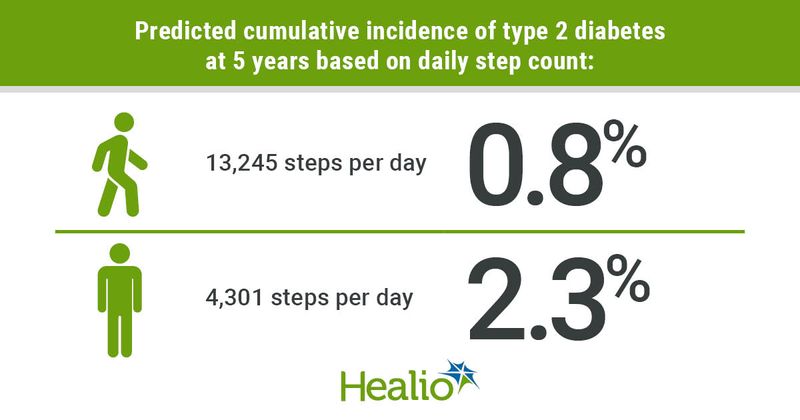Greater physical activity linked to lower risk for type 2 diabetes
More physical activity was associated with a lower risk for type 2 diabetes regardless of age, sex, BMI or sedentary time, according to an analysis published in The Journal of Clinical Endocrinology & Metabolism.
“We investigated the relationship between physical activity and type 2 diabetes with an innovative approach using data from wearable devices linked to electronic health records in a real-world population,” Andrew S. Perry, MD, cardiovascular research fellow at the Vanderbilt Translational and Clinical Cardiovascular Research Center at the Vanderbilt University Medical Center in Nashville, Tennessee, said in the related press release. “We found that people who spent more time in any type of physical activity had a lower risk of developing type 2 diabetes. Our data shows the importance of moving your body every day to lower your risk of diabetes."

Researchers evaluated data from 5,677 adults (median age, 50.9 years; 74% women) and their personal Fitbit devices from the NIH’s All of Us research program between 2010 and 2021. The program had an aim to advance individualized health care through enrolling at least 1 million participants and their health data.
During a median follow-up period of 3.8 years, researchers observed 97 cases of incident type 2 diabetes. The HR for incident type 2 diabetes was reduced by 44% when adjusting for age, sex and race among participants with an average daily step count of 10,700 compared with participants with an average of 6,000 steps (P = .01). This association persisted even after adjusting for BMI (HR = 0.62; 95% CI, 0.41-0.93).
Participants in the 90th percentile with 13,245 steps per day had a predicted cumulative incidence of type 2 diabetes of 0.8% at 5 years compared with 2.3% among participants in the 10th percentile with 4,301 steps per day.
Researchers observed similar benefits among groups based on their average duration of various physical activity intensities, such as lightly active, fairly active or very active. The median daily step count across all monthly averages was 7,924 steps, median fairly active physical activity per day was 15.96 minutes, and median very active physical activity per day was 16.06 minutes.
There was no evidence for an effect modification by age, sex, BMI or sedentary time.
“Future studies should aim to extend these findings to more racially diverse populations to confirm the generalizability of these findings,” the researchers wrote.
Reference:
- Women who take more steps per day may have a lower risk of diabetes. endocrine.org/news-and-advocacy/news-room/2022/women-who-take-more-steps-per-day-may-have-a-lower-risk-of-diabetes. Published Dec. 13, 2022. Accessed Dec. 13, 2022.
